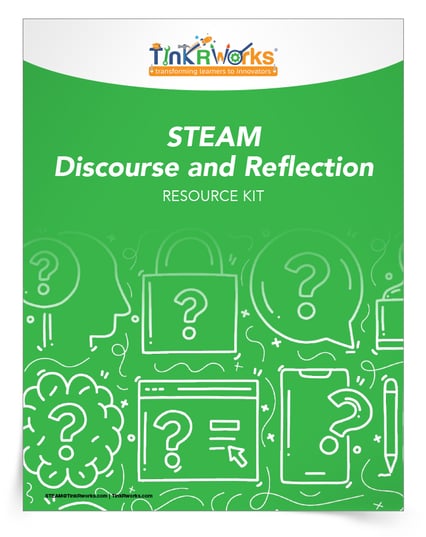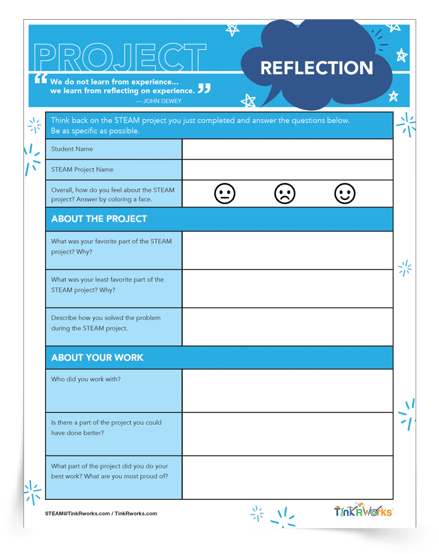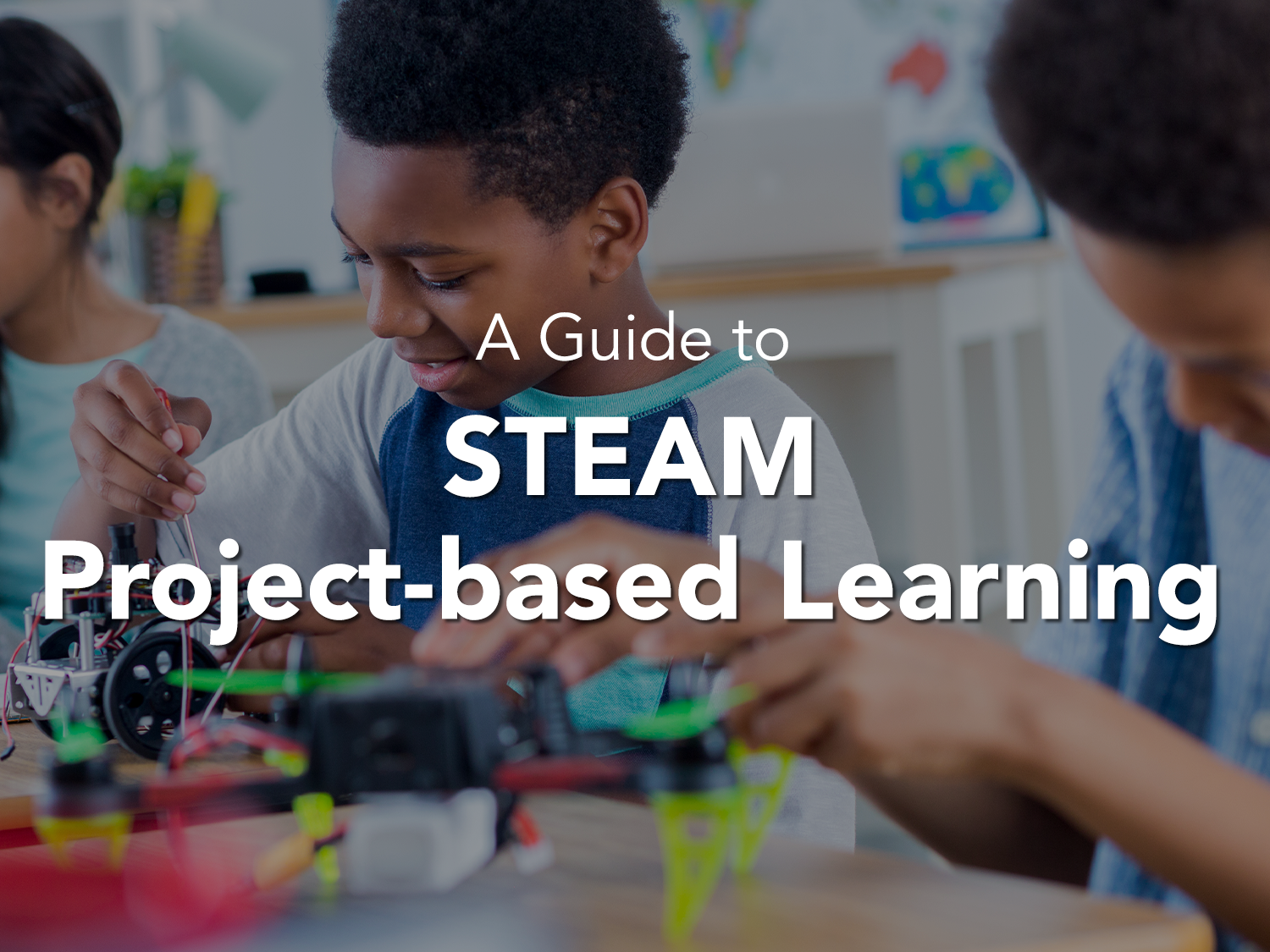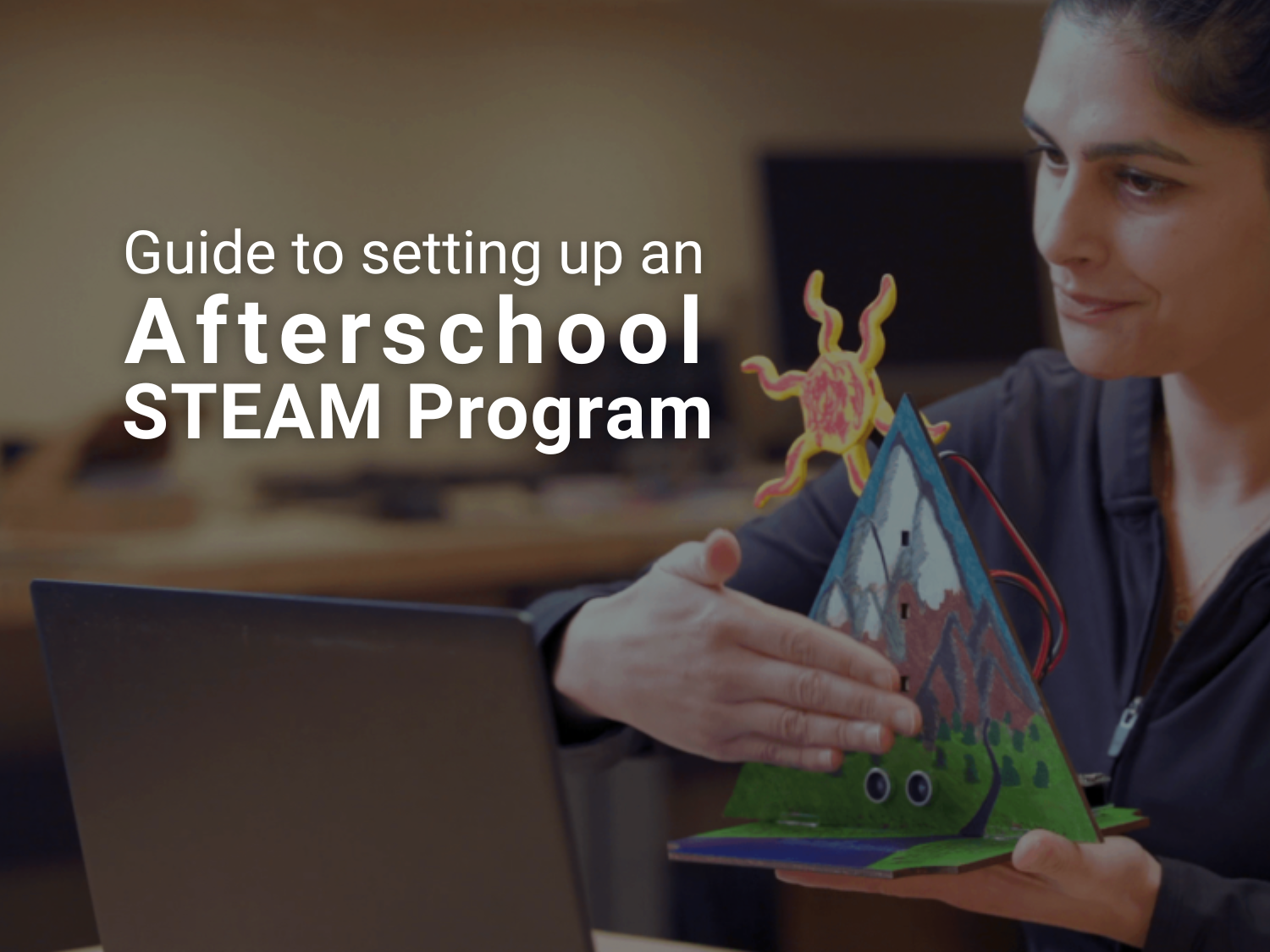Enhancing STEAM with Discourse and Reflection
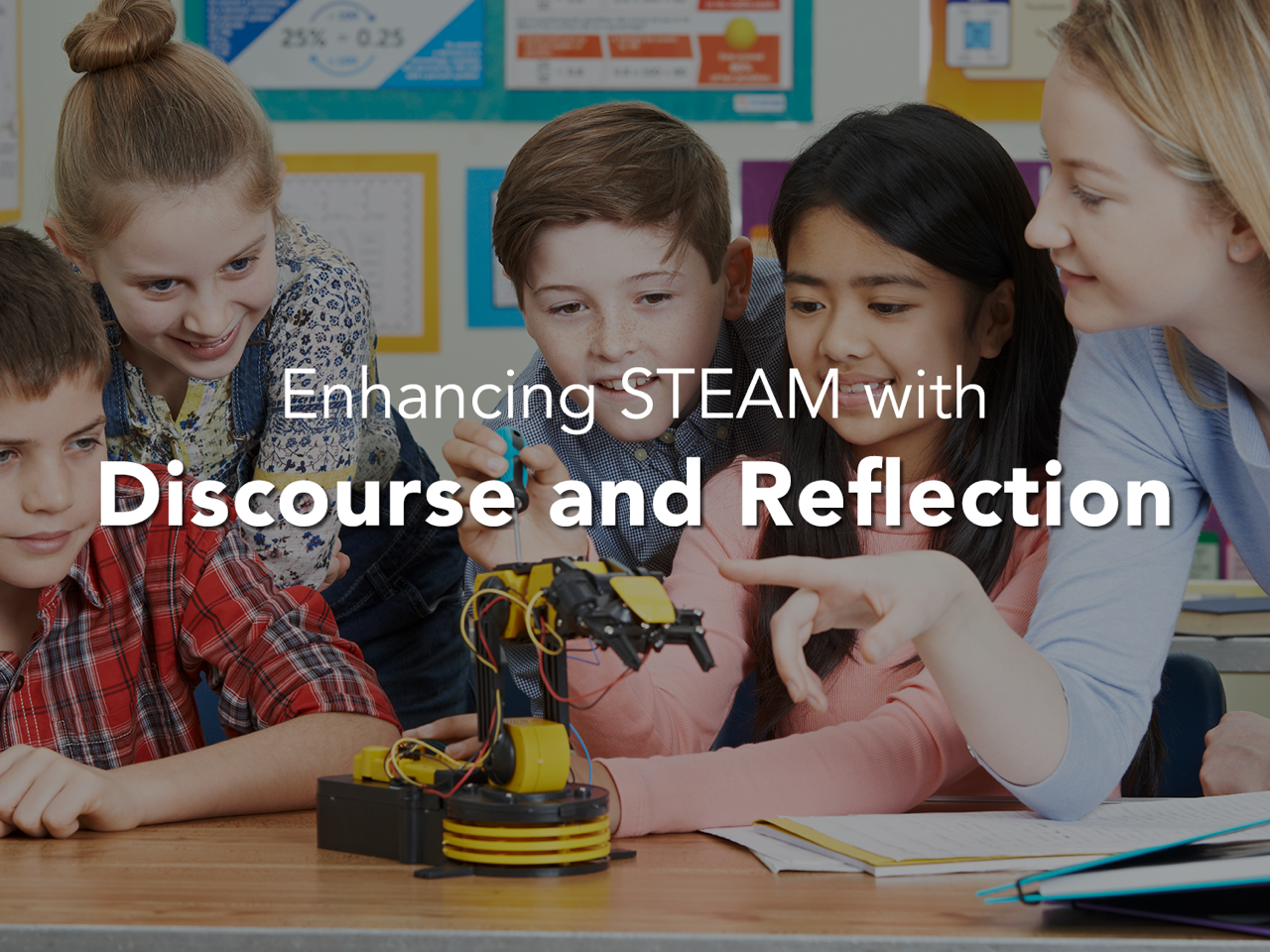
Any experienced STEAM teacher can tell you that while instructor guidance is highly important, student voices should remain central. In this article, we discuss the importance of and how to cultivate discourse, questioning, and reflection during STEAM projects. Plus, download our free STEAM Discourse and Reflection Resource Kit!
One of the most vital aspects of a vibrant STEAM-centered classroom is student-led discourse, rich with purposeful questioning, high-level conversations, and self-reflection. Discourse is a key component to a STEAM-centric classroom for so many reasons, including…
- Ensuring students are actively involved in the learning process
- Allowing educators and students to get the most out of STEAM lessons
- Creating an environment that develops two vital 21st century skills: collaboration and communication
- Deepening students’ understanding of content by requiring them to use and apply the information during higher order thinking tasks, such as questioning, synthesizing, debating, explaining, etc.
In addition, studies show that authentic classroom discourse increases student buy-in and engagement; when students feel their voices are heard and valued it engenders feelings of safety, community, and belonging in the classroom.
But nurturing high-level discourse among students takes intentionality and careful planning. For STEAM lessons to be truly effective, educators need to prioritize discourse, employ purposeful questioning, and encourage students to reflect on what they’ve learned.
Discourse in STEAM Education
To cultivate the next generation of scientists, engineers, mathematicians, and innovators of all kinds, educators must teach students how to think, question, evaluate, and argue like them. One of the most critical steps in doing so is to prioritize discourse. But not just any discourse will do! Teachers must show students how to differentiate between conversational discourse and scientific discourse.
Discourse vs. STEAM Discourse
Scientific discourse varies greatly from standard discourse. In conversational discourse…
-
People may just be exchanging ideas
-
People may rely on power, persuasiveness, and emotional appeals (think ethos and pathos)
-
Usually, the goal of the conversation is to “win” by developing the most convincing argument
In contrast, scientists and engineers rely on robust STEAM-centric discourse as part of the investigative process. This type of discourse is highly unique in that it…
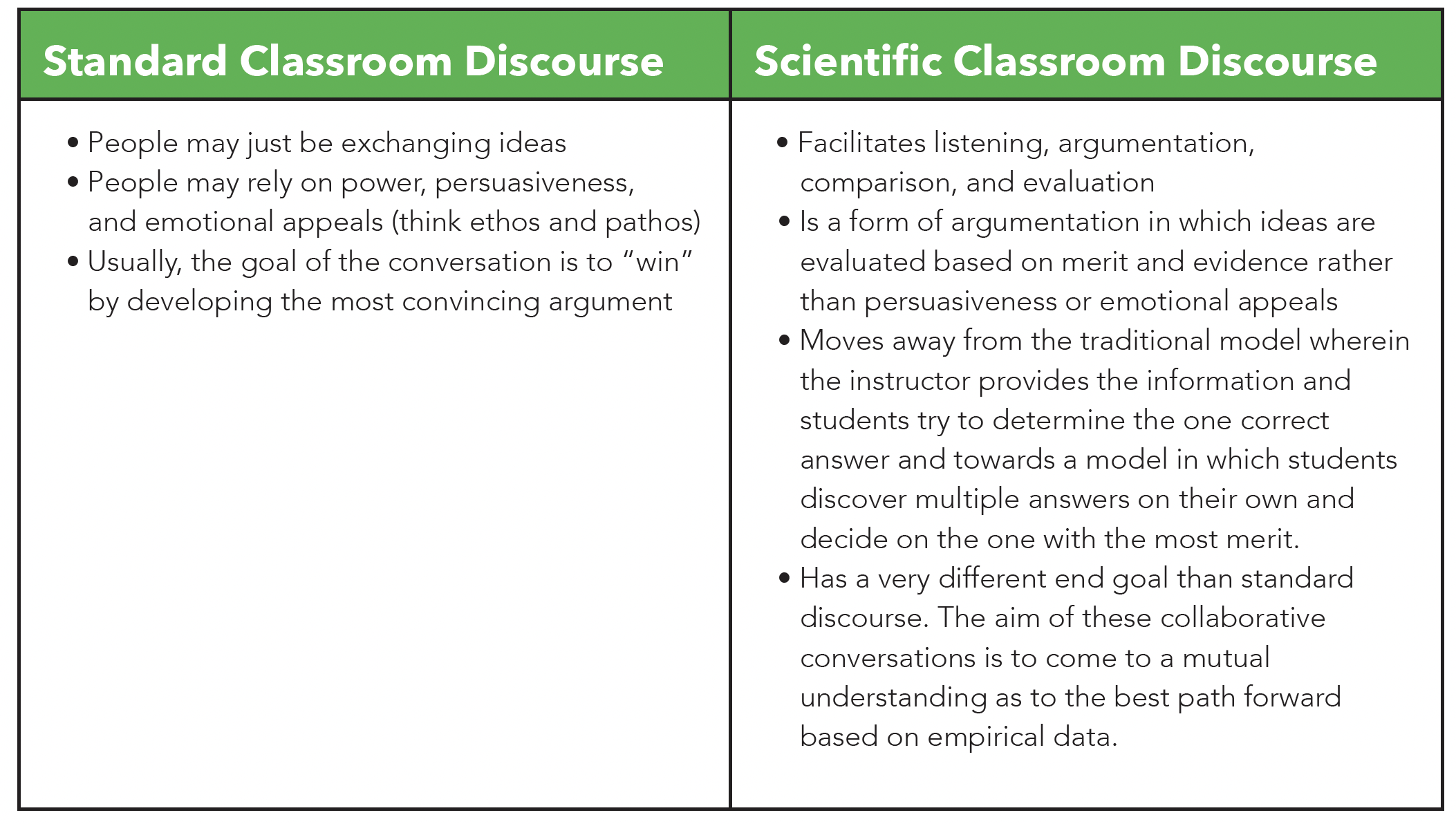
Educators' Roles in Facilitating STEAM Discourse
To ensure students are equipped with the skills needed in the 21st-century workforce, it’s vital that they learn how to engage in meaningful STEAM discourse. To facilitate this, teachers should take some time to reflect on their current practices, learn ways to improve and investigate outside resources to help if needed.
If you’re a STEAM educator wondering how to facilitate scientific discourse in your classroom, take some time to ask yourself…
- How often do students really talk deeply through their ideas during STEAM projects?
- Are you employing any discourse strategies to enrich academic conversations?
- When was the last time you refreshed your discourse practices with current, research-based strategies?
- Do current district staff and PD providers offer teachers the resources and opportunities to develop more STEAM discourse strategies?
- Does school leadership have protocols to measure how well discourse is being promoted during STEAM education
- To what extent does current STEAM instruction prioritize student understanding/sense-making through collaborative conversations?
- In what ways does discourse in STEAM education attend to equity? Are underserved students being supported and engaged in discourse as well as others?
If you’re feeling discouraged after reflecting on your current practices or just need a bit of a revamp in your STEAM discourse strategies, you’re in the right spot! We’ve got some great ideas for improving the quality of discourse in your STEAM lessons.
How to Orchestrate Productive STEAM Discourse
- Make sure you fully understand the components of scientific discourse
- Set clear expectations for students
- Model, establish, and mediate STEAM-centered discourse practices
- Maintain collaborative patterns of communication that foster productive STEAM discourse
- Keep discourse rigorous
- Gauge the success of your discourse strategies and modify them if necessary
However, it’s one thing to know you need to refresh your discourse strategies and another thing entirely to find the right ones to use. The good news is that there is a plethora of high-quality resources out there to help engage kids in academic discourse and help make your STEAM lessons more successful. From educational blogs with free downloads for teachers to ready-to-use projects (like the amazing ones from TinkRworks), there are so many options out there to help jumpstart discourse in your STEAM- classroom!
Two other sure-fire ways to get your students arguing, defending, and talking like scientists are purposeful questioning and self-reflection.
Purposeful Questioning in STEAM Education
By far the most valuable tool to promote classroom discourse is purposeful questioning. Traditionally, instructors use questions to engage students, keep them focused, and assess whether they have learned the information needed to progress with the lesson. For questioning to give rise to high-level STEAM discourse, educators need to employ a different type of questioning: the purposeful kind.
Purposeful questioning paired with adequate amounts of think time (whether individually, in pairs, or in groups) will allow students the opportunity and time to think deeply and respond to these questions. Rather than just asking factual information with one correct answer, purposeful questions should be open-ended, deep-thinking questions with multiple possible answers, all of which require research and time to compose a response.
Each STEAM lesson already begins with a larger question and/or problem that must be solved. But tapping into kids’ inquisitiveness shouldn’t end there! Purposeful questions should also be employed throughout the duration of STEAM projects to help get kids to think deeply and connect with the material. But what types of questions you ask during each phase will look quite different:
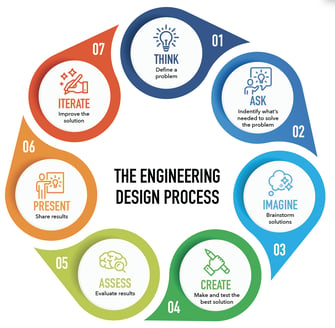 Think
Think
- What is the problem you need to solve?
Ask
- What needed to be done to solve the problem?
- Do you have any constraints? What are they?
- What will success look like for you in this project?
Imagine
- What are some possible solutions for this problem?
- Does this remind you of another problem you have seen or solved? How?
- What materials do you have and how can you use them?
Create
- For each part of our design, what materials will you need to collect?
- Given the constraints, which of these projects could you realistically finish?
- What jobs will you assign to the people in your group?
- What could go wrong when you start building?
- Who will complete each part of the design?
- What challenges do you anticipate, and what can you do to plan for them?
Assess
- Did you hit all the necessary requirements with your design?
- What did you notice while you were designing and testing?
- What went well? What didn’t go well?
Present
- Does your design work? Does it solve the problem?
- Does anything need to be improved?
- If you had to start the design process all over again, what would you do differently?
- How can this help you fix a problem in the real world?
- What other designs in the class went well and why?
Improve
- How does your design need to be improved?
- What do you need to change?
- Who will perform the changes in your group?
Purposeful questioning ultimately helps move students towards the goal of your STEAM lesson by putting them into a STEAM-centered mindset and helping them think in a scientific way. Engaging in this type of inquiry also propels them into the deep levels of thinking needed to negotiate, evaluate, and ultimately come up with their own solutions.
But getting kids to think deeply and engage in this type of discourse doesn’t happen by accident or on the fly during instruction. Teachers need to be intentional about pre-planning the purposeful questions they will ask during each portion of the lesson/project.
One other incredible byproduct of using purposeful questioning in the classroom is that students eventually begin to mimic these questions within their peer groups. When using questioning strategies in class, you’re modeling for students how to ask these same types of deep questions to their peers. Another way to get students to engage in purposeful questioning in their work groups is to provide them with question stems for each phase of the project. Having a reference page or notecard of question stems can help them get started in a more approachable manner.
Need more ideas to help you use purposeful questioning in the STEAM classroom? Check out our amazing, free, and brand-new STEAM Discourse and Reflection Resource Kit.
Student Reflection in STEAM Education
One other worthwhile strategy for sparking deep classroom discourse during STEAM is reflection. Whether it’s individually, with a partner, or as a whole group, reflection can enhance classroom talk and help students make sense of class content.
Reflection is also a key step in the scientific discourse process–a skill they will need and use frequently in their future careers as scientists, engineers, and innovators. When reflecting, students learn to explain and defend their findings to others, so that they can come to a mutual understanding with their peers as to the best possible solution to the design problem. The reflection process also allows them to take responsibility for their own learning and pushes them into the deep-thinking required of metacognition.
When students reflect on what went well and how they could improve in the future, it also helps foster a growth mindset. A mindset of “what could I do better next time,” also engenders grit, resilience, and a feeling of confidence. Students see themselves as builders, explorers, and innovators who can eventually find a great solution with enough tweaks and improvements. This type of growth mindset is key to the STEAM fields where innovation requires continual tinkering to discover the best solution or produce the best product.
Two effective strategies for getting kids to reflect are open-ended questions and structured reflection strategies.
Open Ended-Question Sentence Starters to Facilitate Classroom Discourse
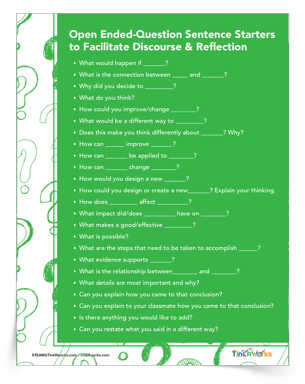 What would happen if _______?
What would happen if _______?- What is the connection between _____ and _______?
- Why did you decide to _________?
- How could you improve/change ________?
- What would be a different way to _________?
- Does this make you think differently about _______? Why?
Another way to encourage students to stop and reflect on the learning process is to use structured reflection strategies.
Structured Reflection Strategy Ideas
- Journaling
- Students respond to an open-ended question by writing a journal entry.
- Fist-to-Five
- Students use fingers (fist = zero, 5 fingers = 5) to answer reflection questions. Questions might be, “How well did your project go?”, “How did your group work together today?”
- Partner Sharing
- Students answer reflection questions with partners and share answers with the whole group
- Group Sharing
- Students sit in a circle and share what went well and what they would improve with the whole group.
Thinking up your own reflection questions can sometimes be tricky (especially after a long day of teaching!). To get access to some free student reflection worksheets specific to STEAM, download the STEAM Discourse and Reflection Resource Kit!
In Summary
High-level scientific discourse is key to any successful STEAM classroom. But this type of collaborative community must be cultivated by teachers and practiced by students. In order to nurture STEAM-centered discourse, educators should promote scientific over standard discourse, reflect (and possibly refresh) their discourse strategies, use purposeful questioning, and employ reflection tools. For more support in nurturing STEAM discourse in your classroom, download a free copy of our STEAM Discourse and Reflection Resource Kit.
-1.png?width=350&height=89&name=TinkRworks%20Logo_Learners%20to%20Innovators%20V2%20(1)-1.png)
